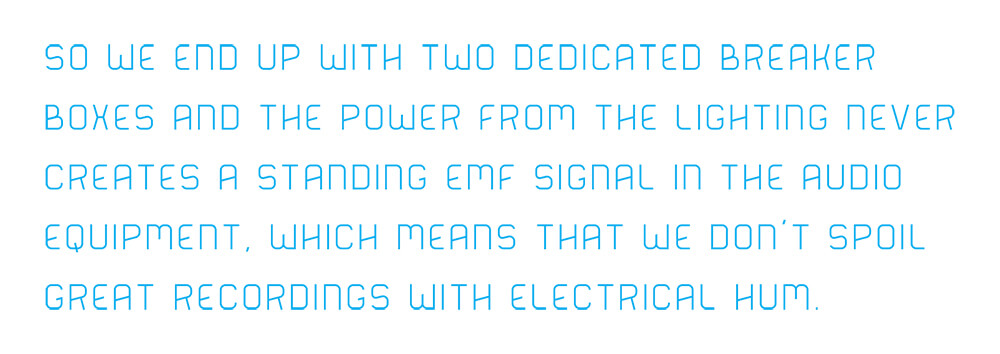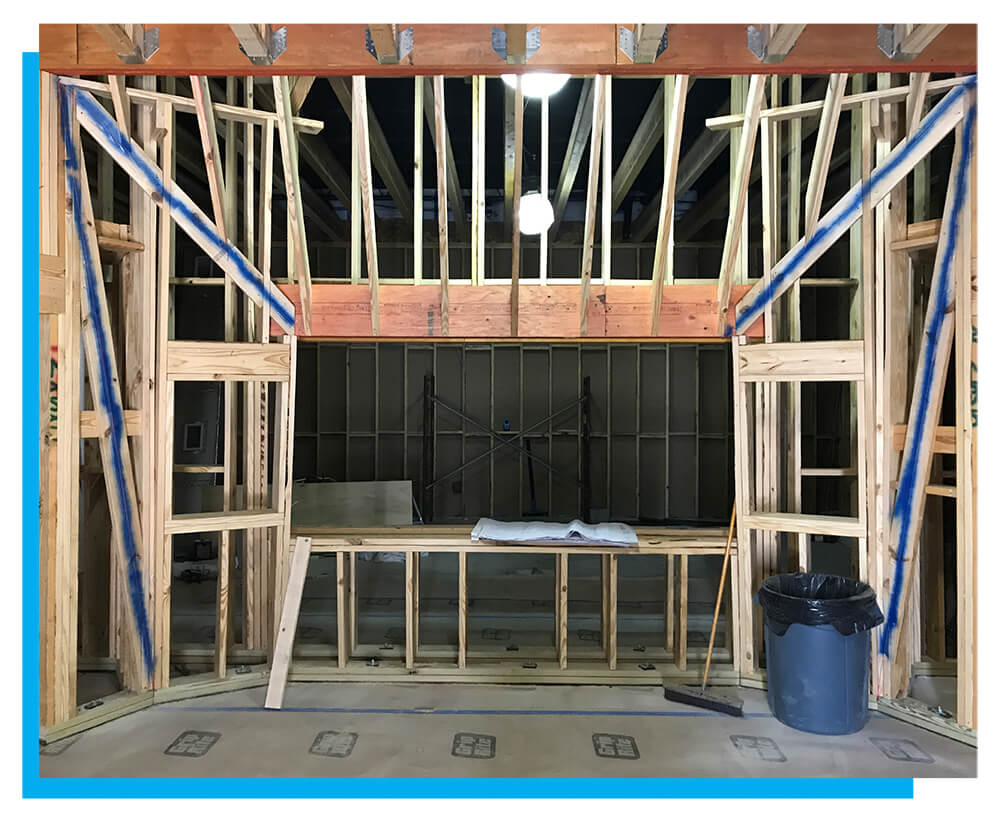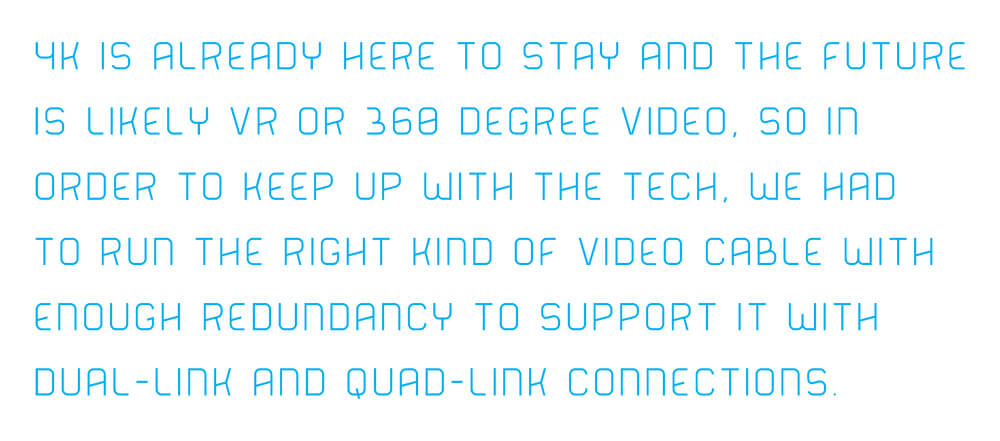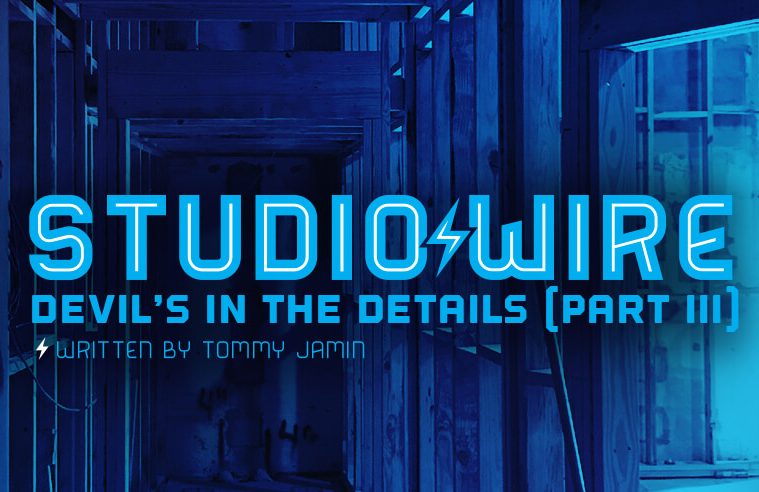After a few long days of manual labor climbing through the rafters above the new studio, I’ve just completed pulling thousands of feet of audio/visual cabling and installing the mic tie-line panels to the framing members. As each one of these days draw to a close, I pull off my sweat-soaked clothes and reflect on the accomplishment I feel after working with my hands. It feels good, hand-crafting an element of this studio’s critical infrastructure myself, springing forth the ornate (albeit hidden) nervous system upon which the productivity of our sessions will be built. It’s a nice departure from the typical day to day in front of a computer screen.
 Our culture has produced a seemingly infinite number of quotes about the importance of “paying attention to the details” in executing any plan with excellence; this hold true in every sphere of our existence. Great athletes, chefs, artists, businessmen, you name it, they all attribute their secret ingredient to the focus they put on the details of their trade. Looking back to when we began this project nearly a year ago, we were consumed with the macro-level aspects of this endeavor, and it was the job of our architects to worry about the details. As we transition now from plans on paper to physical manifestation, I’ve noticed my own perspective on the project evolving into something altogether much more micro.
Our culture has produced a seemingly infinite number of quotes about the importance of “paying attention to the details” in executing any plan with excellence; this hold true in every sphere of our existence. Great athletes, chefs, artists, businessmen, you name it, they all attribute their secret ingredient to the focus they put on the details of their trade. Looking back to when we began this project nearly a year ago, we were consumed with the macro-level aspects of this endeavor, and it was the job of our architects to worry about the details. As we transition now from plans on paper to physical manifestation, I’ve noticed my own perspective on the project evolving into something altogether much more micro.
 These days are all about the details. When we start digging into the plans with the pros that actually do the work with their own hands, the right kinds of questions get raised. How exactly will the compound, concave angle of the front wall of the control room come together? How in the heck will we route the thousands of feet of video, audio, and data cables throughout the facility and maintain future-proof flexibility for when transmission protocols unquestionably change? What can we do to ensure that our audio lines are free from electromagnetic frequency distortion? How will we avoid the pesky drone of air flowing through the AC registers? Ultimately, how do we make the most of our budget and what tasks can someone like myself do?
These days are all about the details. When we start digging into the plans with the pros that actually do the work with their own hands, the right kinds of questions get raised. How exactly will the compound, concave angle of the front wall of the control room come together? How in the heck will we route the thousands of feet of video, audio, and data cables throughout the facility and maintain future-proof flexibility for when transmission protocols unquestionably change? What can we do to ensure that our audio lines are free from electromagnetic frequency distortion? How will we avoid the pesky drone of air flowing through the AC registers? Ultimately, how do we make the most of our budget and what tasks can someone like myself do?
We started with a freshly-poured concrete floor in the control room. Because we were burying PVC pipe to route cables between the desks and the machine room, the openings of the pipes in the floor had to be placed in extremely precise locations. We referenced a page in the plans with specific x- and y-axis and meticulously followed those coordinates to a T. We measured out the locations, buried the pipes in the dirt, measured again, re-adjusted, and re-checked everything just prior to pouring the concrete.
 Framing the rooms brought about its own challenges. On the one hand, we had a set of plans drawn by an acoustics expert. His M.O. was to design the rooms to act as finely-tuned musical instruments. Think of a beautifully crafted arch-top guitar and the elaborate structure of the sound box, hand-shaped and braced in just such a way to best articulate the sound of that instrument. On the other hand, we had another plan set drawn by a structural engineer solely focused on load support, meeting building codes, and the structural integrity of the rooms. The structural engineer was calling for larger, stouter truss
Framing the rooms brought about its own challenges. On the one hand, we had a set of plans drawn by an acoustics expert. His M.O. was to design the rooms to act as finely-tuned musical instruments. Think of a beautifully crafted arch-top guitar and the elaborate structure of the sound box, hand-shaped and braced in just such a way to best articulate the sound of that instrument. On the other hand, we had another plan set drawn by a structural engineer solely focused on load support, meeting building codes, and the structural integrity of the rooms. The structural engineer was calling for larger, stouter truss
For the electrical rough-in, we also had some details to consider. For one, we have two different types of power circuits throughout the studio. One type is for lighting, computers, and other equipment. These are what we call our “dirty power” outlets. The hum that video lighting, in particular, creates in a circuit can easily spoil an audio signal, so the other type of circuits (which we refer to as star-ground or “clean power”) maintains a completely isolated ground signal from the dirty circuits. So we end up with two dedicated breaker boxes and the power from the lighting never creates a standing EMF signal in the audio equipment, which means that we don’t spoil great recordings with electrical hum. Another critical aspect of the rough-in was the mounting of the electrical boxes themselves. The acoustical finishes of the various walls in the studio will have different thicknesses: some are floated 1 ⅜” off of the studs with hat channel and isolation clips, some have 2” of Owens Corning 705 acoustic dampening, some have binary amplitude Diffsorbor panels, and on and on. Because of this variation in the wall depths, the electrician had to pay extra attention to the plans, placing the electrical boxes at an appropriate depth to accommodate wall treatments that currently only exist as ideas on paper.
For air conditioning, we’ve installed two separate systems: one is for our control room, our machine room, and the amp closet. The other system handles cooling all of the artist spaces: our main tracking room and the two sound locks. It sounds pretty straight forward, but once you start working through the design characteristics of these systems, a whole new light gets shed here also. Being that our specific application requires a critical air velocity at the registers so as not to introduce any
 And of course, back to my beloved low-voltage systems. I can’t say that I’ve become an expert in the field, but I’m learning from the best. There are nine MTL panels throughout the studio; these are similar to the outlet boxes that provide electrical connections throughout your house, except these are for audio/visual/data cabling. For that task, we needed to be sure that we could support a video feed or an audio recording in any room, a headphone cue system in the sound locks for an acoustic guitar or vocal performance, or a surround mix in the control room. High quality Gotham Audio instrument and speaker cabling make it so that the musicians can be in one room and the amplifiers can be cranked to eleven in pristine-quality in another. Furthermore, 4K is already here to stay and the future is likely VR or 360 degree video, so in order to keep up with the tech, we had to run the right kind of video cable with enough redundancy to support it with dual-link and quad-link connections. For what the future brings, we also ran 2” empty raceway pipes to support installing fiber optic lines or whatever protocols the industry throws at us next year, and beyond.
And of course, back to my beloved low-voltage systems. I can’t say that I’ve become an expert in the field, but I’m learning from the best. There are nine MTL panels throughout the studio; these are similar to the outlet boxes that provide electrical connections throughout your house, except these are for audio/visual/data cabling. For that task, we needed to be sure that we could support a video feed or an audio recording in any room, a headphone cue system in the sound locks for an acoustic guitar or vocal performance, or a surround mix in the control room. High quality Gotham Audio instrument and speaker cabling make it so that the musicians can be in one room and the amplifiers can be cranked to eleven in pristine-quality in another. Furthermore, 4K is already here to stay and the future is likely VR or 360 degree video, so in order to keep up with the tech, we had to run the right kind of video cable with enough redundancy to support it with dual-link and quad-link connections. For what the future brings, we also ran 2” empty raceway pipes to support installing fiber optic lines or whatever protocols the industry throws at us next year, and beyond.
Now that the framing, electrical, low-voltage, and HVAC have been installed, I take a step back to admire what we’ve done so far. It’s already looking amazing, and knowing first-hand all of the elements that went into its execution, it just continues to blow my mind. I’ve gained an even greater appreciation for the skilled tradesmen who’ve graced this jobsite with their expertise, and their attention to detail has been testament to the mastery of skilled craftsmanship. It’s still early, but as I look around at what we’ve erected from the cold, featureless concrete, I marvel at the scope of what we’ve accomplished here and how incredible this studio is going to be when it’s finished.


